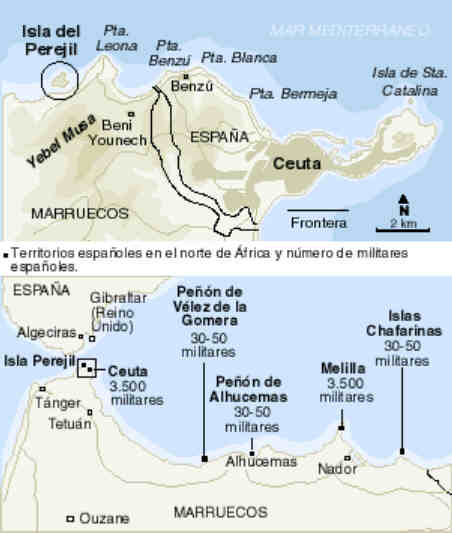 On
a July 17:
On
a July 17: 2002 At 06:21, 28 members of a Spanish special forces team drop from helicopters onto Perejil (“Leila” for the Moroccans) island, 200x550 meters, 200 m from Morocco's Meditarrenean coast, 6 km from Spain's Moroccan enclave Ceuta (which, together with the other enclave, Melilla, Morocco claims, just as Spain claims Gibraltar). The Spanish troops swiftly reach the outcrop's summit, raise the Spanish flag, and from a helicopter use megaphones to demand the surrender of the six Moroccans marines, who, the day before, had replaced the 12 Moroccan gendarmes who, on 11 July 2002, had occupied the normally uninhabited controverted island, and raised the Moroccan flag. The Moroccans surrender and are handed over to Morocco. The whole operation takes less than one hour. — [see the Reuters story]
2000 Bashar Assad, son of Hafez Assad, began a seven-year term as Syria's 16th head of state.
2000 Commémoration de la rafle du Vél'd'Hiv. ^top^
La première journée nationale à la mémoire des crimes racistes et antisémites de l'Etat Français est célébrée le jour anniversaire de la rafle. Le ministre délégué à l'Enseignement professionnel, Jean-Luc Mélenchon, affirme que le souvenir de la rafle du Vél' d'Hiv doit être celui d'une journée de " deuil et de honte pour les Français ". La loi instaurant cette journée nationale a été votée à l'unanimité le 10 Jul 2000. Les 16 Jul et 17 Jul 1942, quelque 4500 policiers français avaient arrêté à leur domicile parisien 13'000 juifs, rassemblés ensuite dans l'ancien vélodrome avant d'être déportés.
A l’été 1942, la puissance nazie est à son apogée : les troupes de Hitler occupent toute l’Europe et, bien qu’elles aient échoué devant Moscou et Leningrad, elles occupent une grande partie de l’Ouest de l‘URSS. En Afrique du Nord, malgré la victoire des forces de la France Libre à Bir Hakeim en juin 1942, l’issue des combats entre les Anglais et l’Afrika Korps est encore incertaine. En juillet 1942, rien n’indique encore le début d’un reflux. Malgré le coup d’arrêt à l’expansion japonaise à Midway en juin 1942, sur le front européen, ce n’est qu’en septembre que les Allemands sont arrêtés à Stalingrad et en novembre qu’a lieu le débarquement en Afrique du nord et le coup d’arrêt d’El Alamein. En France, les conditions de l’armistice prévalent encore à l’été 1942; ce n’est qu’en novembre 1942 que la zone libre sera occupée par les Allemands et leurs alliés italiens. Pétain est à la tête de l’état et son premier ministre, Laval, symbolise la collaboration: il dit souhaiter la victoire de l’Allemagne.
La rafle du Vél'd’Hiv vit la déportation de 12800 Juifs parisiens à la demande des Allemands, tout au moins pour les adultes, les enfants ayant été livrés sur l’initiative du chef du gouvernement, Laval. Auparavant, le régime de Vichy avait promulgué en octobre 1940 le statut des Juifs, qui excluait ceux-ci de nombreuses professions et les mettait à part de la communauté nationale. De leur côté, les nazis ont décidé en janvier 1942 d’exterminer tous les Juifs d’Europe (conférence de Wannsee) et exigent des pays occupés qu’ils livrent les juifs, qui sont envoyés dans les camps d’extermination de Pologne, en particulier Auschwitz. 5 millions de Juifs seront ainsi exterminés. C’est la police française ( et non la milice, qui n’existe pas encore en juillet 1942) qui a procédé aux arrestations. En France, le bilan sera moins lourd, environ 25% de la communauté juive a péri. Le chiffre ne fut pas aussi élevé que dans le reste de l’Europe grâce à « l’action héroïque et fraternelle de nombreuses familles françaises ». Mais sur 78'000 déportés, seuls 3000 sont revenus.
Extrait de l'allocution de Jacques Chirac:
Je veux me souvenir que cet été 1942, qui révèle le vrai visage de la "collaboration", dont le caractère raciste, après les lois anti-juives de 1940, ne fait plus de doute, sera, pour beaucoup de nos compatriotes, celui du sursaut, le point de départ d'un vaste mouvement de résistance. Je veux me souvenir de toutes les familles juives traquées, soustraites aux recherches impitoyables de l'occupant et de la Milice, par l'action héroïque et fraternelle de nombreuses familles françaises. J'aime à penser qu'un mois plus tôt, à Bir Hakeim, les Français libres de Koenig avaient héroïquement tenu, deux semaines durant, face aux divisions allemandes et italiennes. Certes, il y a les erreurs commises, il y a les fautes, il y a une faute collective. Mais il y a aussi la France, une certaine idée de la France, droite, généreuse, fidèle à ses traditions, à son génie. Cette France n'a jamais été à Vichy. Elle n'est plus, et depuis longtemps, à Paris. Elle est dans les sables libyens et partout où se battent des Français libres. Elle est à Londres, incarnée par le Général de Gaulle. Elle est présente, une et indivisible, dans le cœur de ces Français, ces "Justes parmi les nations" qui, au plus noir de la tourmente, en sauvant au péril de leur vie, comme l'écrit Serge Klarsfeld, les trois-quarts de la communauté juive résidant en France, ont donné vie à ce qu'elle a de meilleur. Les valeurs humanistes, les valeurs de liberté, de justice, de tolérance qui fondent l'identité française et nous obligent.
 Deaths
Deaths